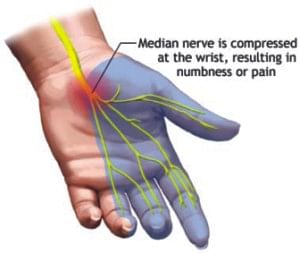| Health
Carpal Tunnel Syndrome
What is carpal tunnel syndrome?
Carpal tunnel syndrome is a specific group of symptoms that include tingling, numbness, weakness, or pain in the fingers, thumb, hand, and arm. These symptoms occur when there is pressure on the median nerve within the wrist. The carpal tunnel is a small space or "tunnel" in the wrist formed by the wrist bones (carpal bones) and a ligament (transverse carpal ligament). The median nerve and tendons pass through the carpal tunnel from the forearm to the hand. Tubes of tissue called tendon sheaths surround the tendons. The median nerve controls movements of the thumb, and supplies feeling to most of the thumb and index finger, middle finger, and part of the ring finger.
What causes carpal tunnel syndrome?
 Carpal tunnel syndrome is caused by activities that put pressure on the median nerve and decrease its blood supply, leading to tingling, numbness, pain, and/or weakness. Any of the following conditions or activities can lead to carpal tunnel syndrome: Carpal tunnel syndrome is caused by activities that put pressure on the median nerve and decrease its blood supply, leading to tingling, numbness, pain, and/or weakness. Any of the following conditions or activities can lead to carpal tunnel syndrome:
* Conditions such as hypothyroidism and rheumatoid arthritis can increase the amount of tissue in the carpal tunnel. The swelling that is common in pregnancy can also crowd structures in the tunnel.
* Wrist injuries, bone spurs, or swelling of the tendon sheath can decrease the space in the carpal tunnel. A common cause of tendon sheath swelling is forceful, repetitive movement of the fingers and hand (such as typing or sewing) especially if the wrist is in an awkward position.
* Diabetes, which increases nerve sensitivity, can make the median nerve more sensitive to pressure.
* Smoking and obesity can each increase the risk of developing symptoms.
What are the symptoms of carpal tunnel syndrome?
Common symptoms of carpal tunnel syndrome are tingling, numbness, weakness, or pain of the fingers or, less commonly, the palm. Symptoms most often occur in the parts of the hand supplied by the median nerve: the thumb, index finger, middle finger, and half of the ring finger. If your little finger is not affected, this may be a sign that the condition is carpal tunnel syndrome, because the little finger is usually controlled by a different nerve than the thumb and other fingers. You may first notice symptoms at night, and you may be able to get relief by shaking your hand.
How is carpal tunnel syndrome diagnosed?
Carpal tunnel syndrome is diagnosed based medical history, a physical exam, and further tests. Your doctor will want to know about health conditions such as arthritis, hypothyroidism, diabetes, or pregnancy. He or she will ask about accidents or injuries of the wrist, arm, or neck. Your daily activities and any recent unusual activities are an important part of your medical history. Your physical examination includes evaluation of the feeling, strength, and appearance of your neck, shoulders, arms, wrists, and hands. Blood tests, if any health conditions are thought to be contributing to your symptoms. Further tests may include:
* Nerve testing to determine whether signals are passing normally down the median nerve.
* X-rays to evaluate the size and shape of the carpal tunnel and your neck.
How is carpal tunnel syndrome treated?
Nonsurgical treatment usually relieves the pressure and pain in the wrist and hand. Mild carpal tunnel syndrome is treated first by changing your habits. If an activity is aggravating your symptoms, you can do it less often, increasing the amount of rest between repetitions, or changing the position you are in. You may want a wrist brace that keeps your wrist straight at night. Stretching and strengthening your hands and arms may help. Treatment may need to include medication for an underlying condition contributing to your carpal tunnel syndrome symptoms. Surgery is an option for treating carpal tunnel syndrome, but it is usually reserved for cases that are disabling and that haven't responded to weeks of treatment. Surgery involves cutting the ligament that forms the roof of the carpal tunnel, making room in the tunnel and relieving pressure on the median nerve. The surgery (carpal tunnel release) is usually successful but in some cases does not completely relieve the numbness or pain. The earlier your condition is diagnosed, the better your chances of relieving the symptoms and preventing permanent damage to the median nerve.
How can I prevent carpal tunnel syndrome?
The first line of defense against carpal tunnel syndrome is to take care of your basic health--maintain a healthy weight, don't smoke, and exercise to maintain your strength and flexibility. Follow doctors' advice if you have chronic conditions such as arthritis or diabetes. In addition, try to keep your wrists in a neutral position during repetitive or stressful hand activities. (Your wrist is generally in a neutral position when you hold a glass of water.) If you begin to notice signs of carpal tunnel syndrome, stop or reduce any activity that stresses your fingers, hand, or wrist, or try changing the way you do that activity.
Copyright (R) thedailystar.net 2007 |
